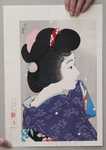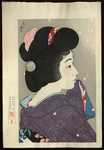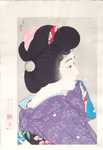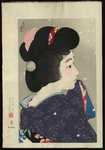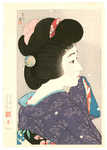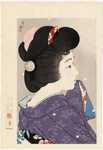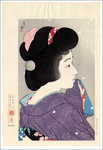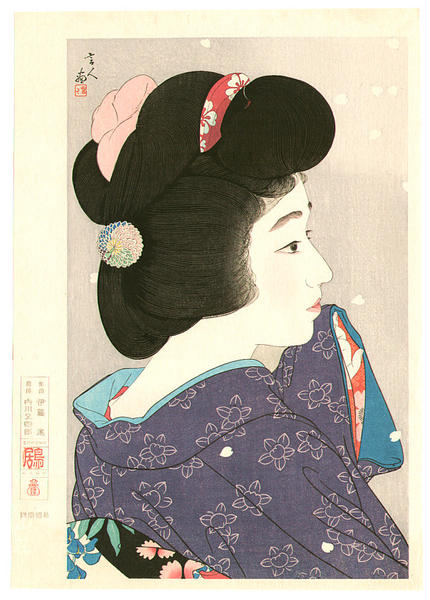| | |
| Artist: | Torii Kotondo (1900-1976) — 鳥居言人 |
| Title: | Misty Spring (Oboro Haru) — おぼろ春 |
| Series: | |
| Date of first edition?: | 1932/4 |
| Date of this artwork?: | 1980s (may not be accurate) |
| Publisher (first edition)?: | Ikeda — 池田 |
| Publisher (this edition)?: | Ishukankokai — 遺珠刊行会 |
| Medium (first edition): | Woodblock |
| Medium (this edition): | Woodblock |
| Format (first edition): | Large Oban
|
| Format (this edition): | Large Oban |
| DB artwork code: | 31051 |
| Notes (first edition)?: |
Dated April 1932 (confirmed).
Limited edition of only 100 prints, after which the blocks were destroyed.
Scene number 4 among 12 Ikeda published scenes.
Has also been called " Hazy Moon in Spring".
Re-issued in the series "Twelve Aspects of Women" circa August 23, 1988. |
|
| Notes (this edition)?: |
| The following information was taken from the original web listing of this artwork. Note that there may be some inaccuracies:
Title Hazy Moon in the Spring - Oboro Haru
Artist Kotondo Torii 1900-1976
Signature Kotondo ga
Seal artist's seal
Dated originally in 1930-31, this one is re-carved edition in 1970s.
Publisher This re-carved edition was published by I-ju Kanko Kai.
Technique/Medium Woodblock print
Impression excellent - very good … (re-carved edition) printed on "sanso" watermarked paper
Colors excellent - very good
Condition excellent - very good
Description "Oboro Haru" (Hazy Moon in the Spring). Beauty is looking at the hazy moon. Cherry petals are falling around her.
Note carver Ito Susumu, printer Uchikawa Matashiro. Iju-Kanko-kai's seal on the left margin.
Format Dai-Oban
Width 12.2 inches = 31.0 cm
Height 17.3 inches = 44.0 cm
Width of Image 10.1 inches = 25.7 cm
Height of Image 16.1 inches = 41.0 cm
Literature Newland, Amy R.; and S. Hamanaka, "The Female Image: 20th Century Prints of Japanese Beauties", Leiden: Hotei, 2000, ISBN 90 74822 20 7, - pg.134, pl.180
Note This print was hand-made by skillful artisans after a great original of a famous woodblock print. Sheets printed during the artist's lifetime are either very expensive or no longer available.
|
|
| Artist Bio: |
| Torii Kotondo (or Torii Kiyotada VIII) is renowned for his paintings and shin hanga prints of beautiful women. His woodblock prints, superbly carved and printed, are comparable with those of Hashiguchi Goyo and Ito Shinsui. Kotondo was born with the name Saito Akira in the Nihonbashi district of Tokyo. He was the only son among the five children of Torii Kiyotada, the seventh Torii master. The Torii school had a long tradition of painting and printmaking for the Japanese theater, extending back to the seventeenth century. Kabuki theater was still very popular in the early twentieth century and prints and painted posters were the primary means of publicity. Although Kotondo was mainly interested in studying history and archaeology, it was assumed that he would follow in his father's footsteps and join the Torii school. At age 14, Kotondo agreed to leave school and begin studies with Kobori Tomone, a yamato-e painter. Along with painting classes, Tomone taught Kotondo about the court and military practices of ancient Japan, satisfying his interest in history. A year later, he was officially adopted as the next heir of the Torii school and assumed the artist's name 'Kotondo'. While still studying with Tomone, he began designing illustrations for a theatrical magazine, Engei Gaho ('Entertainment Illustrated Magazine'), and painted kabuki posters and billboards. Torii Kotondo was the 8th Torii and the 5th Torii Kiyotada. His father was the 4th Kiyotada.
|
|




